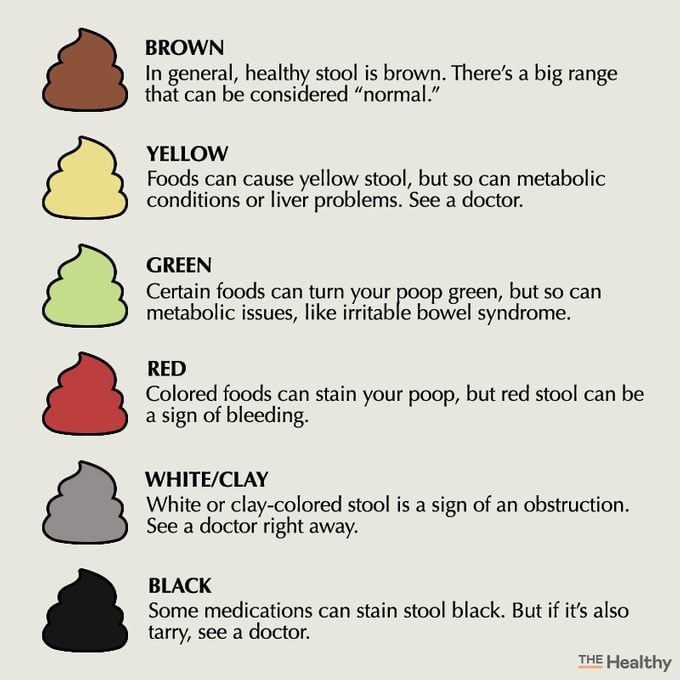Imagine this: you walk into the bathroom, do your business, and glance down at the porcelain throne. But instead of the usual brown, your poop has a strange, two-toned appearance – maybe a hint of green, a streak of yellow, or even a spot of red. What’s going on? Is this something to worry about? The answer, as with many things in life, is complex and depends on a myriad of factors.

Image: reneolele.blogspot.com
Let’s dive into the fascinating (and sometimes a little bit gross) world of poop color, exploring the reasons behind this peculiar phenomenon and when it might be a cause for concern.
Understanding the Rainbow in Your Toilet Bowl
The color of your poop is primarily determined by what you eat and how your body digests it. Your diet plays a huge role. Think of your poop as a mirror reflecting what you’ve been consuming – like a culinary crime scene investigation in your digestive tract.
The Basics of Brown:
- Bilirubin: This pigment, a breakdown product of old red blood cells, is responsible for the typical brown color of poop.
When Colors Change:
-
Green Poop: This often indicates a fast transit time through the digestive system. It could be caused by food like green leafy vegetables, or by diarrhea.
-
Yellow Poop: Could be a sign of excess fat in your stool. It can also point to dietary changes or conditions like celiac disease.
-
Red Poop: This can be alarming, and often indicates bleeding in the lower digestive tract. However, it could also be caused by foods like beets or red food coloring.
-
Black Poop: This is usually a sign of digested blood in the upper gastrointestinal tract. This is a serious situation that requires immediate medical attention.
Deconstructing the Two-Tone Mystery
When your poop has two different colors, it can be a little unnerving. Let’s break down the potential causes and when you should reach out to a medical professional:
1. Diet and Food Sensitivity:
- The Color Contrast: Some foods naturally produce different colored stools. Eating a significant amount of berries could cause purple streaks, while certain leafy greens might result in a green hue.
- Food Intolerances and Allergies: Sudden changes in your poop color could indicate a food intolerance or allergy. For example, lactose intolerance can lead to a pale, yellowish stool. If you’ve recently introduced a new food into your diet, pay close attention to how your body reacts.
2. Medication and Supplements:
- Iron Supplements: Iron supplements can often turn your stool black or dark green.
- Antacids: Antacids containing bismuth subsalicylate can cause black stools.
3. Medical Conditions:
- Infections: A gastrointestinal infection can significantly alter your poop’s color and consistency.
- Celiac Disease: This autoimmune disorder can lead to a variety of digestive symptoms, including yellow or pale-colored stools.
- Irritable Bowel Syndrome (IBS): While IBS doesn’t directly affect poop color, it can cause changes in stool frequency, consistency, and urgency, which can alter how your stool appears.
- Hemorrhoids: Bleeding from hemorrhoids can cause red streaks in your stool, especially if you’re straining during bowel movements.
- Ulcerative Colitis and Crohn’s Disease: These inflammatory bowel diseases can cause a range of digestive issues, including changes in stool color and consistency.
4. The “Taco Tuesday” Effect:
- Dietary Fluctuation: Have you recently indulged in a spicy meal or a lot of red meat? These dietary changes can temporarily affect the color of your poop.
Navigating the Two-Toned Territory: When to See a Doctor
While two-toned poop can sometimes be a harmless anomaly, it’s important to recognize when it might be a sign of something more serious.
Seek immediate medical attention if:
- Your poop is black, tarry, or bloody.
- You experience severe abdominal pain, fever, or vomiting alongside the color change.
- The color change persists for more than a few days.
Schedule an appointment with your doctor if:
- Your stool color changes persistently and you can’t pinpoint a dietary reason.
- You experience any other unusual symptoms, such as diarrhea, constipation, or changes in stool consistency.
Tips for Keeping Your Digestive Tract Happy
- Fiber Up: Eat plenty of fiber-rich foods like fruits, vegetables, and whole grains to keep things moving smoothly.
- Hydrate: Drink plenty of water to keep your digestion regular.
- Mind Your Medications: Be aware of any medications or supplements that might affect your bowel movements.
- Listen to Your Body: Pay attention to any changes in your poop and discuss them with your doctor if you have any concerns.

Image: www.thehealthy.com
Why Is My Poop 2 Different Colors
The Bottom Line
Your poop holds a wealth of information about your health and digestion. While a two-toned bowel movement might seem a little unsettling, it’s often nothing to worry about. However, if you notice any persistent changes or unusual symptoms, it’s always best to consult with your doctor to rule out any underlying medical conditions. In the end, understanding your poop is just another step towards a healthier, happier you.






